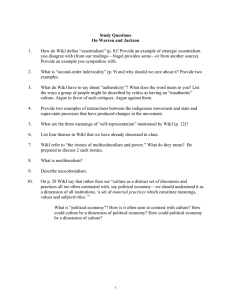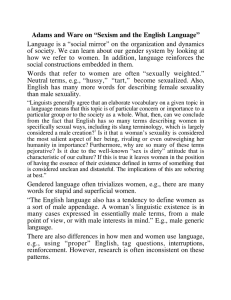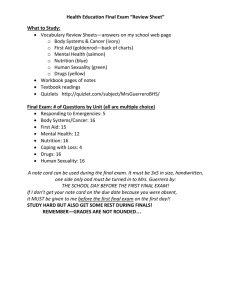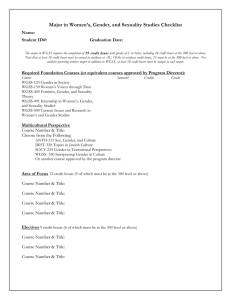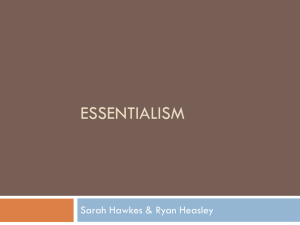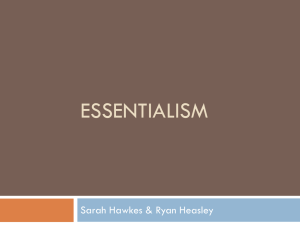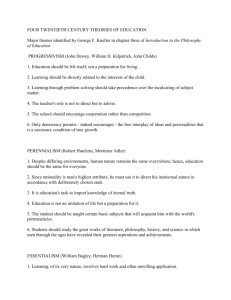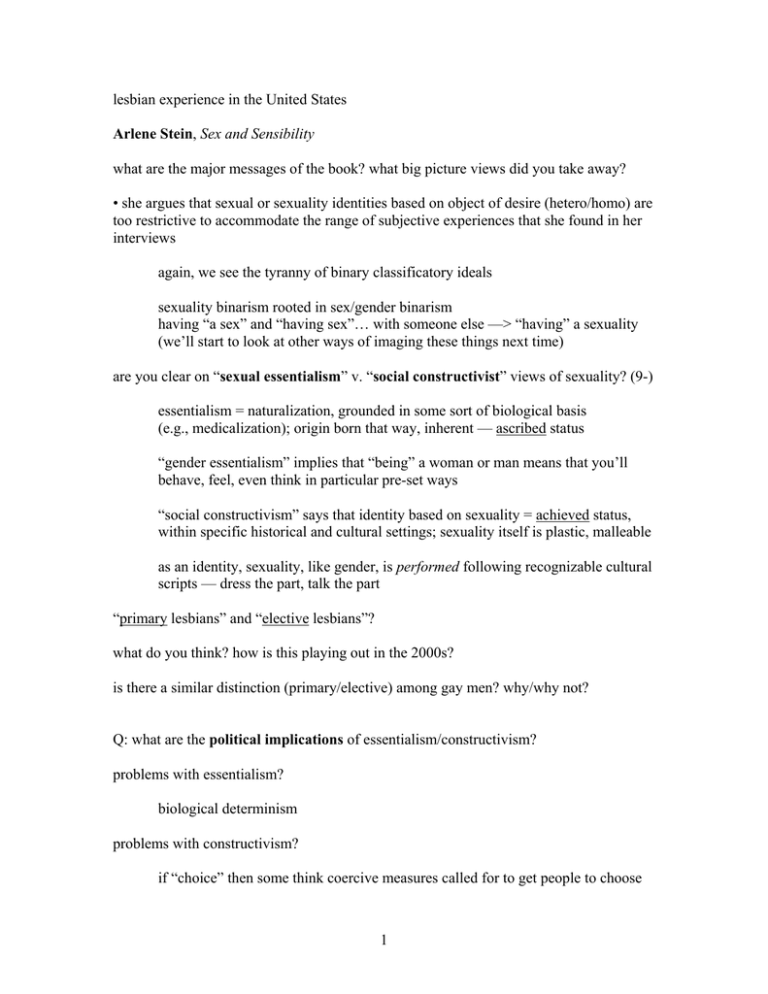
lesbian experience in the United States
Arlene Stein, Sex and Sensibility
what are the major messages of the book? what big picture views did you take away?
• she argues that sexual or sexuality identities based on object of desire (hetero/homo) are
too restrictive to accommodate the range of subjective experiences that she found in her
interviews
again, we see the tyranny of binary classificatory ideals
sexuality binarism rooted in sex/gender binarism
having “a sex” and “having sex”… with someone else —> “having” a sexuality
(we’ll start to look at other ways of imaging these things next time)
are you clear on “sexual essentialism” v. “social constructivist” views of sexuality? (9-)
essentialism = naturalization, grounded in some sort of biological basis
(e.g., medicalization); origin born that way, inherent — ascribed status
“gender essentialism” implies that “being” a woman or man means that you’ll
behave, feel, even think in particular pre-set ways
“social constructivism” says that identity based on sexuality = achieved status,
within specific historical and cultural settings; sexuality itself is plastic, malleable
as an identity, sexuality, like gender, is performed following recognizable cultural
scripts — dress the part, talk the part
“primary lesbians” and “elective lesbians”?
what do you think? how is this playing out in the 2000s?
is there a similar distinction (primary/elective) among gay men? why/why not?
Q: what are the political implications of essentialism/constructivism?
problems with essentialism?
biological determinism
problems with constructivism?
if “choice” then some think coercive measures called for to get people to choose
1
differently (not as politically safe as essentialism; owing to our views of nature)
doesn’t answer the question of why some people “feel” one way or the other
how to understand people who are convinced they were “born gay”? or for that
matter, happily heterosexual?
neither framework necessarily accommodates the variety among, say, lesbians or among
straight women — and each overemphasizes differences between categorical groupings
According to Stein, in the1980s lesbian feminism started coming apart at the seams —
tension b/w “born lesbians” and “women-identified” lesbians who might still fantasize
about men but were politically committed to women’s community, resisting patriarchal
marriage, etc.
it’s interesting to note that lesbianism as a self-proclaimed identity emerged from the
women’s movement, as a subset of those challenging restrictive roles for women
generally (the gay men’s movement came out of a different politics)
“coming out of the closet” — what is this?
ritual of self-definition
classically revealing to others one’s deepest, most authentic inner self
the confession
for some, ritual performance that demonstrated commitment to a cause and to an
identity (i.e., more about the social identity than the personal identity)
Katz (22): “the social construction of homosexual persons [he means that in a historic
sense — including the social construction of essentialism!] has lead to the development
of a powerful gay liberation identity politics based on an ethnic group model. This has
freed generations of women and men from a deep, painful, socially induced sense of
shame, and helped to bring about a society-wide liberalization of attitudes and responses
to homosexuals.”
but is there also a flip side to the positive?
reinscribed hetero/homo as essential categories — “Who am I? Which am I?”
“identity politics” — idea that what you believe is/should be based on who you are — it’s
essentializing, potentially limiting
BUT might be politically strategic; “strategic essentialism”, form of “necessary fiction”
• Is “coming out” as culturally important today as a rite of passage?
• How strong do you see the divide b/w straight and gay as KINDS of sexuality? any
differences beyond preferred gender?
2
MIT OpenCourseWare
http://ocw.mit.edu
21A.231J / WGS.455J Identity and Difference
Spring 2006
For information about citing these materials or our Terms of Use, visit: http://ocw.mit.edu/terms.

